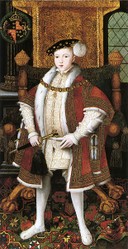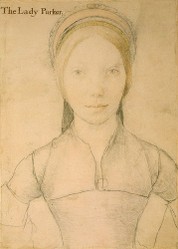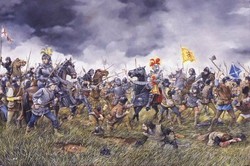The statue is small, a mere forty six centimetres by 23, but the dowel holes in the back inform us that it was affixed to an altar piece.This means that it came from a church rather than a domestic dwelling, a fact that is important as there were copies of the Walsingham image made in the mediaeval period. Investigators have found traces of paint on the statue's surface, so at one time it had been well-maintained.There is some damage, for one hand is missing, why we know not.
The seal of the priory of Walsingham, found on surviving documents,shows us what the statue looked like, and in 1931 an Anglican clergyman, Henry Fynes Clinton, noted that the statue was almost identical to the image on the seal.He said that it came from a church now destroyed. This is significant, as only monastic churches were destroyed at the Reformation, parish churches survived. So we are dealing with a monastic image, and nearby Walsingham was the prime candidate.Clinton speculatively hoped that we had found the long-lost statue. A high church Anglican, he was sympathetic to the revival of the shrine that was taking place.
The way that the Langham Madonna differs from the image on the Walsingham seal is that the seal's image shows Mary with a veil, whereas the Langham Madonna has no veil, but this is not very significant because it is possible that the Madonna had a cloth veil replaced daily.
A mistake in provenance might have delayed recognition. There is another Langham. Besides the Langham in Norfolk where the statue was found, there is a Langham in neighbouring Essex. The museum authorities assumed that we had got the statue from Essex Langham, but Fynes Clinton said that it came from the Norfolk one. The clue that it was from Norfolk comes from the fact that Langham in Essex still has its pre-reformation church, as does Norfolk Langham. So the pointers go back to a mediaeval monastic church.
Descendants of the Calthorpe and Rookwood families cannot be traced to give any further information, for their estates were sold long ago and family history would probably have been long forgotten.So there is no information from that source. The museum that bought the statue was originally of the opinion that it was a copy, a rarity in its own right. The Victoria and Albert Museum in London is a large, high status museum specialising in artistic items, so it will want to maintain the highest standards of proof and provenance before coming to any conclusion.
Of course, in history proof is not possible, there is only justification. Maybe we will never know if this is the lost image. Or maybe an untold story will be discovered.










 TheThousand Year Gardenon 11/26/2025
TheThousand Year Gardenon 11/26/2025
 Women of the Gospelson 10/11/2025
Women of the Gospelson 10/11/2025
 Religious Gardenson 08/25/2025
Religious Gardenson 08/25/2025
 Doctor of the Church: John Henry Newmanon 08/03/2025
Doctor of the Church: John Henry Newmanon 08/03/2025




Comments
Probably, but they will be reasonable and geared to pIlgrims's needs.MANCHESTER
Thank you for your comment below, on Nov. 29, 2023, in answer to my previous, same-day observation and question.
Your answer alerts us to public cemeteries as open to all. Are there set visiting hours?
Public cemeteries are openntonall. Private cemeteries are not.
Family history and genealogy amateurs and professionals access graves, thereby accounting for the existence of Find a Grave.
Does the "ordinary" public get to access private and public cemeteries on your eastern side of the Atlantic pond?
I do not know why the families are untraceable. Sometimes records are lost, maybe because of accidents.
The fifth paragraph to the second subheading, The statue and its provenance, alerts us that "Descendants of the Calthorpe and Rookwood families cannot be traced to give any further information, for their estates were sold long ago and family history would probably have been long forgotten."
July 30, 2019, you answered my previous, related question that day with the reply that "I do not know why Calthorpes and Rookwoods are untraceable."
I associate British Isles-er with the world-best family historians and genealogists.
Might it be possible that family history and genealogical indices preserve the last known families with whom the Calthorpe and Rookwood families intermarried? If not, might it be known the exact places and times when all traces perished?
Such an endeavor seems no longer possible on Ancestry, where dates and names with their boxes checked for exact spellings and times send no results and dates and names with their boxes not so checked send results for any name and time other than those requested.
We usually accept the place names that we inherited, no need for change.
Word origins and their progression into other pronunciations and spellings interest me.
A few minutes ago I looked for Langham online.
English Wiktionary makes Langham an Old English phrase for "long homestead" (from lang hām).
It might be unlikely for eastern pondersiders to evolve the aforementioned name into something in line with Modern English, correct? (That occurs among western pondsiers ;-{!)
Of course. Historical records omit much, material that recorders think unimportant and material they may not want to preserve. Recordsvare sometimes accidentally destroyed.
No historical account of someone or some place somewhere in the British Isles goes against my image of British Isles-ers as the world's best family historians and genealogists (even as the New York Public Library and the New England Genealogical Society acquit themselves quite nicely ;-D)!
Is it possible that there are area oral traditions when the historical account falters?